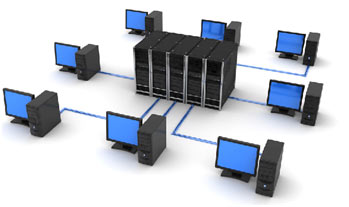A computer network is a group of computer that use a set of common communication protocols over digital interconnections for the purpose of sharing resources located on or provided by the network nodes. The interconnections between nodes are formed from a broad spectrum of telecommunication networks technologies, based on physically wired, optical, and wireless radio-frequency methods that may be arranged in a variety of network topologies.
The nodes of a computer network may include personal computers, servers , networking hardware , or other specialized or general-purpose hosts. They are identified by hostnames and . Hostnames serve as memorable labels for the nodes, rarely changed after initial assignment.
Computer networks may be classified by many criteria, including the transmission medium used to carry signals, bandwidth , to organize network traffic, the network size, the topology, traffic control mechanism, and organizational intent.
Applications
Computer networks support many applications and services, such as access to the world wide web, digital video , digital audio, shared use of application and storage servers, printers, and fax machines, and use of email and instant messaging applications.

Uses
A computer network extends interpersonal communications by electronic means with various technologies, such as email, instant messaging, online chat, voice and video telephone calls, and video conferencing. A network allows sharing of network and computing resources. Users may access and use resources provided by devices on the network, such as printing a document on a shared network printer or use of a shared storage device. A network allows sharing of files, data, and other types of information giving authorized users the ability to access information stored on other computers on the network. Distributed computing uses computing resources across a network to accomplish tasks.
Network packet
Most modern computer networks use protocols based on packet-mode transmission. A network packet is a formatted unit of data carried by a packet-switched network. The physical link technologies of packet network typically limit the size of packets to a certain maximum transmission unit (MTU). A longer message is fragmented before it is transferred and once the packets arrive, they are reassembled to construct the original message.
Packets consist of two types of data: control information and user data (payload). The control information provides data the network needs to deliver the user data, for example, source and destination network addresses, error detection codes, and sequencing information. Typically, control information is found in packet headers and trailers, with payload data in between.
With packets, the bandwidth of the transmission medium can be better shared among users than if the network were circuit switched.
Network Topology
Network topology is the layout, pattern, or organizational hierarchy of the interconnection of network hosts, in contrast to their physical or geographic location. Typically, most diagrams describing networks are arranged by their topology. The network topology can affect throughput, but reliability is often more critical.[ With many technologies, such as bus or star networks, a single failure can cause the network to fail entirely. In general, the more interconnections there are, the more robust the network is; but the more expensive it is to install.
Common layouts are:
- Bus network: all nodes are connected to a common medium along this medium. This was the layout used in the original Ethernet, called 10BASE5 and 10BASE2. This is still a common topology on the data link layer, although modern physical layer variants use point-to-point links instead.
- Star network: all nodes are connected to a special central node. This is the typical layout found in a Wireless LAN, where each wireless client connects to the central Wireless access point.
- Ring network: each node is connected to its left and right neighbour node, such that all nodes are connected and that each node can reach each other node by traversing nodes left- or rightwards. The Fiber Distributed Data Interface (FDDI) made use of such a topology.
- Mesh network: each node is connected to an arbitrary number of neighbours in such a way that there is at least one traversal from any node to any other.
- Fully connected network: each node is connected to every other node in the network.
- Tree network: nodes are arranged hierarchically.
Types of network
- LAN(Local Area Network)
- PAN(Personal Area Network)
- MAN(Metropolitan Area Network)
- WAN(Wide Area Network)
